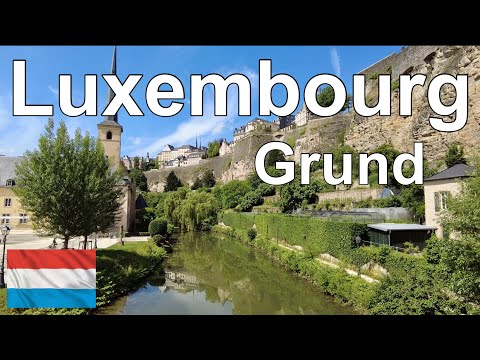Luxembourg City Grund Walking Tour (with subtitles) Summer 2021

We start our walk at the “Corniche”, also sometimes called “the most beautiful balcony of Europe”. The Corniche runs along the Alzette valley on the ramparts - built by the Spaniards and the French in the 17th century. Up to the year 1870 the Corniche had staircases in steep parts which were levelled off only after the dismantling of the fortress.
Moreover the greatest part of the protecting wall with its loopholes was cleared away so as to disclose a superb panorama on the valley of the Alzette, the city district of Grund and the Rham Plateau. The “Spanish Gate” controlled the main access to the city for travelers coming from the South, notably France. The former fortress of Luxembourg had been of great strategic importance for the control of the Left Bank of the Rhine, the Low Countries, and the border area between France and Germany. The fortifications were built gradually over nine centuries, from soon after the city's foundation in the tenth century until 1867.
By the end of the Renaissance, Luxembourg was already one of Europe's strongest fortresses, but it was the period of great construction in the 17th and 18th centuries that gave it its fearsome reputation. Due to its strategic location, it became caught up in Europe-wide conflicts between the major powers such as the Habsburg–Valois wars, the War of the Reunions, and the French Revolutionary Wars. The fortress underwent changes in ownership, sieges, and major alterations, as each new occupier—the Burgundians, French, Austrian and Spanish Habsburgs, and Prussians—made their own improvements and additions. Luxembourg took pride in the flattering historical epithet of the "Gibraltar of the North" as a result of its alleged impregnability.
The city's great significance for the frontier between the Second French Empire and the German Confederation led to the 1866 Luxembourg Crisis, almost resulting in a war between France and Prussia over possession of the German Confederation's main western fortress. The 1867 Treaty of London required Luxembourg's fortress to be torn down and for Luxembourg to be placed in perpetual neutrality, signalling the end of the city's use as a military site. Since then, the remains of the fortifications have become a major tourist attraction for the city. In 1994, the fortress remains and the city's old quarter were listed as a UNESCO World Heritage Site. Nested in the fortified lower town of Luxembourg, just a stone’s throw from the center, the Grund district is known for its cultural and architectural heritage.
With its quiet and relaxing atmosphere, the Grund district is a great place to wander around, in both summer and winter, to enjoy the beautiful landscapes. The Grund was historically the most populated area in the seventeenth century. Today, the Grund is a district with less than 1,000 inhabitants and is preserved from traffic. It is a charming place, which beautifully combines its architectural heritage, culture, and places to go out. On our left is the highly recommended Natural History Museum, certainly worth a visit.
We now approach Neumünster Abbey and Saint John Church on the left. The church of St. John was built at the same time as the Abbey of Neumunster in 1606. The current appearance of the church dates back to the years 1688 and 1705. It contains very fine Baroque-style furniture, an organ dating from 1710 and a black Madonna. The black Madonna dates from the 14th Century.
It was transferred here, together with the baroque altar, in 1805 from Marienthal Abbey. Neumünster Abbey, on the right, served as the state prison from 1867 to 1980. Neumünster Abbey is now a public meeting place and cultural centre where concerts are held regularly. The cultural center hall on the left is named after Robert Krieps, a former Government minister and grandfather of actress Vicky Krieps. This part of the city wall provided protection for the inhabitants of the valley and is known as Wenzel wall. It connects the so-called Lower town and the Rham Plateau to the city’s defence ring. Originally 875 meters long, the wall comprises 37 towers and 15 gates.
The Spanish Turrets were build in the middle of the 17th century, integrated in the large fortifications initiated by the Spaniards and continued by Vauban. The actual purpose of the turrets has not been clearly established. It is said that there were originally 38 of them. On the opposite plateau lie the modern buildings of Kirchberg.
The Red Bridge, built in 1962-63, connects the historical city centre to Kirchberg, the site of the city's European Union institutions and business district. The Three Towers belongs to historic monuments in Luxembourg-City. The square central tower dates from the time of the second fortification ring (probably around 1200) while two circular flanking towers were added in the 14th century.
2021-08-17 02:32


